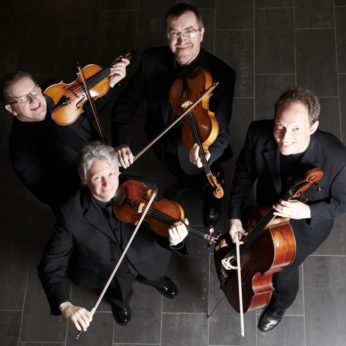The most concise, most secret, no doubt, and most abstract of the six Quartets dedicated to Haydn…austere meditation and gushing optimism are found intimately mingled, and this work is one of the most revealing of Mozart’s mercurial temperament. The E-flat Quartet was the third in this series of quartets that Mozart dedicated to his great friend and colleague, a series that took Mozart over two years to write. That these quartets cost Mozart an enormous effort is revealed not only by their analysis but also by the famous dedicatory letter to Haydn, where they are described as the fruit of long and painful labour. Mozart presents them as his children and entrusts them with touching affection to the sponsorship of his elder.
The friendship between these two great composers has been a source of wonder and admiration to music lovers ever since, especially when you think of the bitter animosities and partisan coteries that have surrounded later composers. Haydn recognised Mozart’s universal superiority early on and he made no secret of it: Friends have flattered me that I have genius, but he surpassed me. When offered an opera commission in Prague, he replied: that would be a too daring thing to do, in that hardly anyone can risk being compared to the great Mozart. This generosity of spirit was reciprocated by the younger composer, who freely admitted that these quartets could not have been written without the groundbreaking work of his mentor.
The opening Allegro begins mysteriously with a sinuous theme played in unison, its character of drifting reverie open to a myraid of possibilities. After a brief crescendo, the veil is lifted and the theme makes its appearance, harmonised with the harsh but invigorating dissonances of the human condition. Triplets and dotted rhythms give the second theme the character of a march and its varied rhythms make up the subject matter of the development section. This is a strange and complex movement and, like the extraordinary slow movement, ti seems to belong to a later era with its probing explorations of musical boundaries.
The Andante is famous for its echoes of Tristan und Isolde long before Wagner was even born. The atmosphere is at once hazy and nocturnal with the warm tones of the strings restricted to the medium-low register. No clear theme stands out from the deliberately flowing, imprecise rhythms. The music uncoils in soothing spirals, blurring the formal outlines that only appear as sonata form on paper. This is Tristan’s kingdom of the night bathed in mystery and subtle changing harmonies. Here is music centred almost exclusively on preoccupations of colour, one of the boldest, most prophetic conceptions of Mozart’s art.
The Menuetto is a startling contrast to the previous movements with its sharp, decisive attack and clear-cut rhythms. However, the harmonic lighting reaffirms itself again and gains in colour to the point of introducing joyful, rustic musette pedals. The Trio revisits the strange world of the Andante with a long, undulating melody, which journeys unpredictably through a series of unexpected keys accompanied again by long pedals. The Finale is a lively rondo, though even this seemingly conventional conclusion retains something of the otherworldly character of the previous movements. Through episodes that are in turn gay or more serious, it hurries towards its witty conclusion, preceded by rests and suspensions – a favourite trick of the dedicatee. This light and joyful creation is brought to a resounding conclusion by four vigorous chords.
